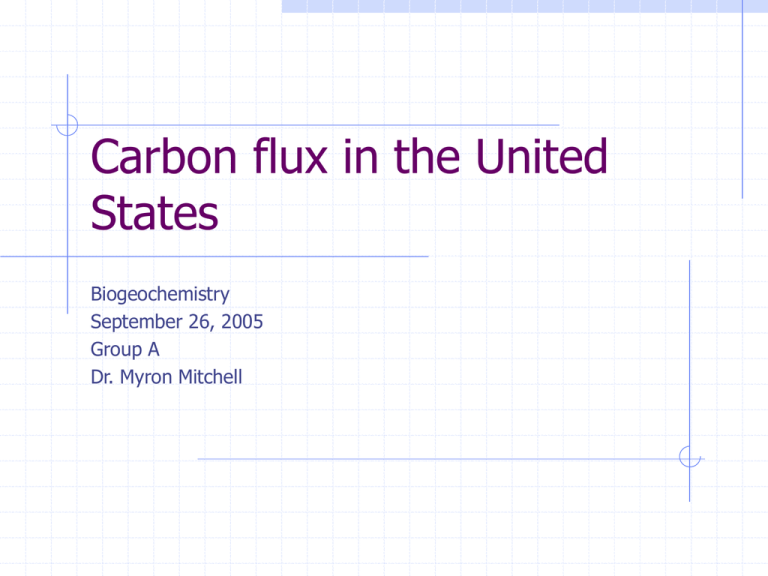Carbon flux in the United States
advertisement

Carbon flux in the United States Biogeochemistry September 26, 2005 Group A Dr. Myron Mitchell Discussion of Research History and Relevance of subject Major points of literature Unanswered questions Research topics for future History of Carbon importance Importance of carbon for atomospheric systems Svante Arrhenius figured industrial inputs could lead to a warming trend "On the Influence of Carbonic Acid in the Air upon the Temperature of the Ground“ Philosophical Magazine 41, 237 (1896) Hogbom & Arrhenius discovered anthropengic additions equal to that of natural processes Was not worried based on current industrial inputs of CO2 Statements were refuted by colleagues The 1930’s &40’s Many theories emerging in relation to CO2 additions Hilburt(1931) Simpson (1937) Hutchinson (1948) “"The self-regulating mechanisms of the carbon cycle can cope with the present influx of carbon of fossil origin." 1950’s and 60’s Began to have wider recognition of CO2 importance Books published increasing public awareness Silent Spring by Rachel Carson The Genesis Strategy: Climate and Global Survival by Stephen Schneider The Cooling by Bryson Seminal work of Keeling (1960) Mauna Loa CO2 Measurements from 1958 to 2002 Congress increasingly aware NEPA (1969) RCRA(1976) Clean Water Act (1977) 1980’s to today Ice cores and Ecosystem studies demonstrate rise in CO2 levels Genthon et al. (1985) Schimel (2000) Relevance CO2 issue actively researched in multiple fields Necessary for understanding and prediction of global trends Major Points Authors address global and regional changes Specific numbers for carbon pools by authors Authors generate numbers using numbers of harvestable forest land and models Major points Need for Standard Metric for obtaining and analyzing data Some sinks could become sources Various biogeochem cycles affect eachother Nitrogen deposition is not a cause of increased carbon assimilation Unanswered Questions and Weaknesses Issues of measuring carbon: all authors have different numbers and criteria Very little discussion of how to address problem Exactly where is the sink, and does its location matter Unanswered Questions and Weaknesses Pacala et al. give carbon sink as 0.30 – 0.58 Pg C/year Field and Fung estimate carbon sink of 2 Pg C/year Unanswered Questions and Weaknesses 12.7 Pg C Live Vegetation in Forested Land for Coterminous US, Goodale et al. 600 – 1000 Gt (544 – 907 Pg) Living biomass in Terrestrial biosphere for the major reservoirs on Earth, Falkoski et al. Unanswered Questions and Weaknesses Unanswered Questions and Weaknesses Little consideration of Oceans No consideration of grass lands Data used was incomplete Accuracy of models Unanswered Questions and Weaknesses Carbon flux in Southern Hemisphere Need more current data Need to form a global model to see net fluxes Research Topics To what degree are other biogeochemical cycles interrelated? The role of nitrogen deposition needs to be further elucidated in grasslands and estuarine communities. Relation to fire ecology? How do the slash and burn policy in tropics effect this cycle? Research Topics Break regions down and get a more accurate budget of carbon for specific areas. Southern hemisphere – South America, Africa, India, South Pacific, Australia More research on plant physiology over time stomatal decreases? Aquatic species could be indicators of how much CO2 the oceans are absorbing Will land use trends continue? Works cited Hulburt, E.O. (1931). "The Temperature of the Lower Atmosphere of the Earth." Physical Review 38: 1876-90. Hutchinson, G.N. (1948). "Circular Causal Systems in Ecology." Annals of the New York Academy of Sciences 50: 221-46. Keeling, Charles D. (1960). "The Concentration and Isotopic Abundances of Carbon Dioxide in the Atmosphere." Tellus 12: 200-203. Simpson, George C. (1937). "Ice Ages." Proceedings of the Royal Institution of Great Britain 30: 125-142 Genthon et al, Vostok ice core: climatic response to CO2 and orbital forcing changes over the last climatic cycle. Nature 329, 414 - 418 (01 October 1987 http://chimie.scola.acparis.fr/sitedechimie/hist_chi/text_origin/arrhenius/Arrhenius2.htm





